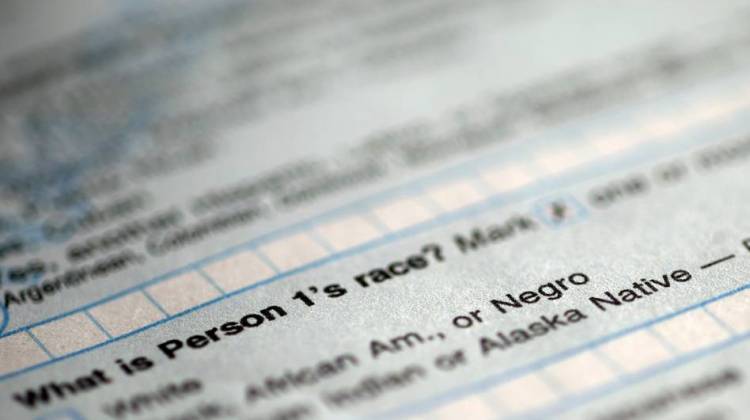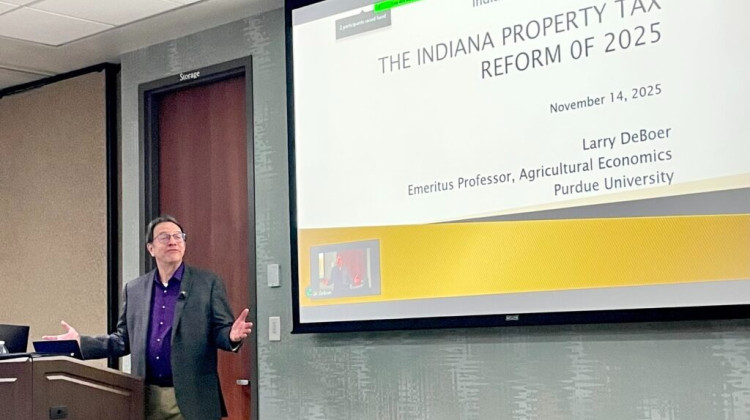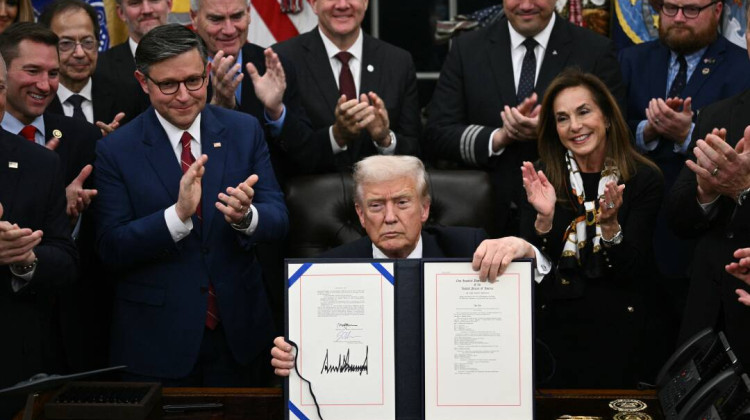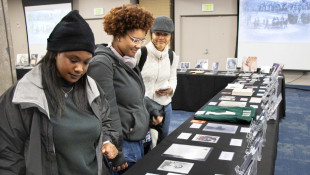Race is a much more elastic concept than we tend to acknowledge. American history has seen lots of immigrant groups that were the targets of suspicion and even racial violence — Jews, the Irish, Germans — gradually subsumed into the big, amorphous category of whiteness. The trajectory of that shift has been a little different for each of those groups — and notably, was informed by the fact that they were not black — but that's been the general template of immigrant assimilation. For much of our history, the process of becoming American has meant becoming white. (Word to Nell Irvin Painter.)
A lot of people wonder if the same might eventually happen to Latinos, who sit at the center of contemporary conversations and anxieties around immigration. The New York Times' Nate Cohn beat that drum last month after coming across some preliminary research from the Census bureau. The researchers were given access to anonymous Census records from the same households for the most recent two surveys in 2000 and 2010.
Before we go further, it's helpful to remember how racial identity was queried in the most recent Census. Respondents first declare whether they are Hispanic — which was not counted as a race on the 2010 form — and in the next question, they were asked to give a race. For people who did check Hispanic on the Census, they would also then check the box for white, black or Asian. Respondents could and did write in "some other race," (More on the Census category for "Hispanic" in a later post.)
The preliminary findings from the researchers, showed that millions of people had changed their racial identification during that period — and people who identified as Hispanic were the group most likely to change their identification. The takeaway, Cohn wrote, was that a very large number of people who were "Hispanic" in 2000 were, in fact, calling themselves "white" by 2010.
"An estimated net 1.2 million Americans of the 35 million Americans identified in 2000 as of "Hispanic, Latino or Spanish origin," as the census form puts it, changed their race from "some other race" to "white" between the 2000 and 2010 censuses, according to research presented at an annual meeting of the Population Association of America and reported by Pew Research. ...
"The data also call into question whether America is destined to become a so-called minority-majority nation, where whites represent a minority of the nation's population. Those projections assume that Hispanics aren't white, but if Hispanics ultimately identify as white Americans, then whites will remain the majority for the foreseeable future."
Cohn's conclusions, in effect — might America's much-discussed brown future be forestalled by Latinos becoming white people? — touched off a firestorm on the blogosphere. The folks at Latino Rebels felt that Cohn was oversimplifying just how complicated Latino identity is — much too complicated to draw broad conclusions about how Latinos will identify themselves, they argued. Meanwhile, Manuel Pastor, a sociologist at the University of Southern California, pointed out that the wording of the Census question changed between 2000 and 2010, which had an effect on how people answered. ("For this census, Hispanic origins are not races," the 2010 form read.) Indeed, Pastor said, his own research suggested that the longer Latinos were in the United States, the less likely they were to identify as white.
Both Cohn's assertions and the push-back to them has overshadowed the research itself, which is much less prescriptive about the future of America. But what the researchers found was no less fascinating. (The final data hasn't been released yet, and the researchers say it may not be completed until the end of the summer. Since the numbers might still change, they've held off on giving out specific figures with their findings.)
The researchers did find a whole lot of people shifting from Hispanic and "some other race" in 2000 to Hispanic and white in 2010. But as they pointed out to me, a "similar" number of respondents went in the opposite direction, — from Hispanic and white to Hispanic and "some other race."
"We think it's interesting that the moves are parallel and in opposite directions," said Carolyn Liebler, a sociologist at the University of Minnesota who is working on the study. "Our idea of assimilation is that people would be moving in one direction in terms of identification. But it's not really a story that allows for the idea that people would move in the other direction. So a lot of stories that sociologists have told about how these things have worked are really not suited to what our research is finding."
Sonia Rastogi, a statistician with the Census Bureau, agreed. "The larger point that everyone is sort of missing is that we're sort of seeing these inflows [into one racial category] and outflows of quite similar magnitude," she said.
Racial Churn
But, importantly, it wasn't just Latinos who were switching races. Both Native Americans and Native Hawaiians saw lots of movement into new categories. Other groups, like non-Hispanic whites, non-Hispanic blacks, and non-Hispanic Asians, saw some change too, but relatively little.
Might there be something distinct about people opting out of one or more racial categories and into another? Liebler, whose academic work has focused on Native Americans in particular, said that it was too soon to tell. But what they found among Natives so far was that there wasn't much difference between the individuals opting out of Indian identification and those opting in. The same might be true for other groups.
It's probably more useful to think of this phenomenon not so much as racial switching, but as racial churn.
So just why is all this churn happening? Rastogi stated any number of things could be at work, like the context in which the respondents were asked the race question. "Different life experiences might change [the way they identify]: if their social circumstances changed, if they're socioeconomically well-off," she said.
If racial churn seems an unlikely idea, then consider all of the things that might happen over the course of a person's life that changes how they identify — the loss of language competency, marriage, retro-acculturation or new revelations about your family history. Or consider the fascinating reporting this year by my colleague, Shankar Vendatam. He spoke to sociologists who tracked thousands of young people in a longitudinal survey over many years, and they found that one in five of the people in the study had at least one racial change. Those changes, it seemed, were driven by some kind of change in their circumstances. So, for example, if a person told an interviewer that they had experienced some kind of downward mobility, they were more likely to see themselves and be seen by others as black.
But the researchers also stressed that there's no reason to think that any of this as new. Liebler pointed to Census data from a half-century ago as an example: between 1960 and 1970, nearly a half-million more Americans identified themselves as Native American — a number that was too large to be explained by mere population growth, she said. Something else had to explain it.
What's different here, the researchers said, was the sheer size of the dataset they're working with — details on a staggering 168 million Americans — which will allow them to get a better sense of the scale of all this movement.
"It's not a particular surprise," she said. "Demographers and other sociologists have studied this before, but we're able to see it on a broader society-wide level."
A History of Changing Boxes
Pastor, one of the most vocal skeptics of Cohn's reading of the Census data, concluded his critique at the Huffington Post by way of personal disclosure. "And for the record, I marked Latino and 'other' both years," he wrote. "I value consistency in my answers as well as in the questions."
The Census question for race, though, has never been consistent. Indeed, a few months ago, a Census official told me that the questions for racial identity have been worded differently in every decennial survey. You can get a sense of how much that changed by looking at the first census from from 1790 and the form 100 years later, in 1890. The first one inquired about the number of "free white males, age 16 and upwards," "free white males, under 16 years," "free white females." The last category was "slaves." In 1890, respondents were asked whether they were "white, black, mulatto, quadroon, octoroon, Chinese, Japanese or Indian." ("Quadroon" denoted anyone who was ¼ black, while an "octoroon" was 1/8th.) The "Hispanic" category wouldn't show up until eight decades later. This question will always be a reflection of the particular racial politics of the moment, and so it will always necessarily be in flux.
As new categories and identifications become available, people will have new ways to contextualize their experiences. Consider that between 2000 — the first year people could choose more than one race — and 2010, the number of folks who said they were multiracial grew by 32 percent, and the number of Americans who identified as both black and white in that span jumped 134 percent. Now think of the many different ways those same people might have identified at another time in our history: white, black, mulatto, octoroon, quadroon.
How do we accommodate a future in which racial and ethnic designations could become even more precise and varied? There are currently 11 boxes on the form for Americans of Asian and Pacific Islander descent. And it's not hard to imagine there being many more — for instance, there are no specific categories for Arab-Americans or Persian-Americans.
Right now, the Census Bureau is seriously mulling whether to make "Hispanic" its own standalone racial category in 2020, as a way to get more accurate responses. But it's an exceedingly tough task: there's a seemingly infinite combination of human experiences, and only so many boxes that might fit on a page.
9(MDEwMDc1MzM3MDEzNDczOTA0MDc1MzViMQ001))
 DONATE
DONATE







 View More Articles
View More Articles



 Support WFYI. We can't do it without you.
Support WFYI. We can't do it without you.